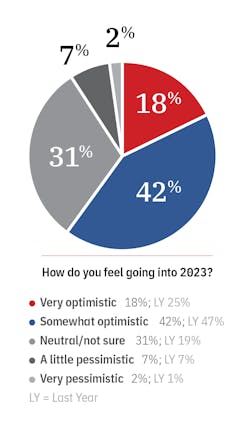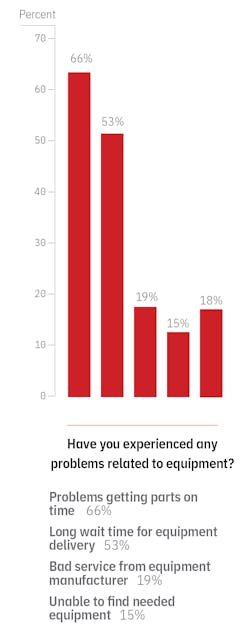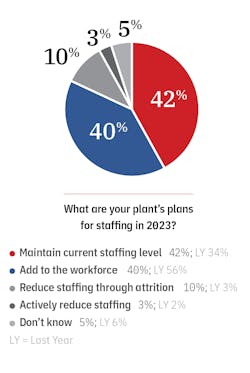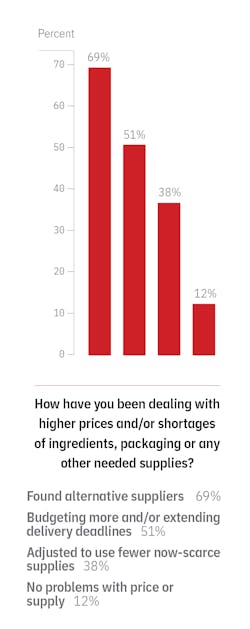Optimism (but not overwhelming) and plans for expansion will be a big part of 2023, if the responses to our Manufacturing Survey are anything to go by.
This optimism is reflected in plans for the near future. Some 77% of respondents anticipate that this year, their company’s plant production will increase, with 21% saying it will go up by 20% or more over last year. Another 27% said they expect output to go up by 10% to 19%. Only 6% think that their companies’ production will go down.
Asked about immediate plans for production capacity, 42% said their companies would probably expand production by opening lines or plants. Another 36% said their companies would stay the same, and only 14% anticipated that lines or plants would be closed.
Our respondents’ predictions for their companies’ capital budgets in 2023 show that they expect this trend to continue. Just over half (54%) said they expect their capital spending to increase, with 20% saying it will go up more than 10%, and another 21% saying it will rise 5% to 10%. Only 9% of respondents anticipated a drop in capital spending.
Upgraded buildings will remain a priority in capital spending; at 25%, it was the most popular choice from a list presented to respondents. The next most popular response was process equipment, at 20%, followed by packaging equipment at 13%.
Some of the respondents added comments that, in some cases, gave intriguing hints as to what their companies are planning – things like “We are modernizing our brewing system”; “new filler and two micro blend mixers” and “adding a new packaging line, milk standardization before going into vats.”
Others weren’t as fortunate: “Unfortunately, due to inflation, we will withhold any projects and stick to expenses on maintenance.”
Help wanted
The labor shortage is one of the biggest things on the minds of food company leaders right now, and our survey respondents were no exception. Asked an open-ended question about “vital manufacturing issues” not elsewhere covered, several respondents returned to the labor situation, with comments like “labor shortage, quality of available labor” and “the increase of capacity while dealing with automation & worker shortages.”
The nature and requirements for labor in food plants are constantly changing, with automation creating a demand for workers with specialized skills. We asked what respondents’ companies were doing to find such workers, and the most frequent response by far, at 55%, was “expanding in-house technical training.” Other popular responses were “adding in-house engineering capabilities” (26%), “hiring more line operators for semi-automated tasks” (24%) and “outsourcing more job functions” (23%) (multiple responses were permitted).
Specialized skills are especially in demand for maintenance functions. When we asked what strategies were being followed for maintenance, the most popular answer, at 48%, was “on-the-job training.” In addition, 40% said they are trying to hire more maintenance technicians, but 42% said they are assigning routine maintenance duties to machine operators. (Again, multiple responses were permitted.) Other popular options were using third-party maintenance services (31%) and using condition-monitoring tools to drive preventive maintenance (27%).
That last has to do with digital technology, which is an area where the food industry is still undergoing growing pains. Asked what they are doing in that area, the most popular answer was the most basic one: “Replacing paper records with electronic records,” chosen by 24% of respondents. The next most popular one was, essentially, nothing: “No action/taking a wait-and-see approach” was selected by 21%. Other popular options were “shifting from local servers to cloud computing” (17%) and “providing more remote access to machine controls” (13%).
There are plenty of other issues, of course. Ask to rank a list of them, a plurality of respondents had “food safety” as the most popular choice, followed closely by “cost control” and “inflation/price increases.”
Supply problems
Only 12% reported having no appreciable problems in obtaining needed supplies of ingredients, packaging or other vital materials. Asked about coping strategies, 69% reported seeking alternative or supplementary suppliers; 51% said they were budgeting more for supplies and/or extending their delivery deadlines; and 34% said they have adjusted formulations or other procedures to use fewer of whatever is in short supply. (Again, multiple responses were permitted.)
A couple of people furnished ad hoc written answers that included “more open communication with suppliers” and “address the government supply chain regulations and shortcomings.”
A somewhat similar pattern took place when it comes to equipment, which was affected by supply chain difficulties and labor shortages in 2022 just as much as consumable supplies like ingredients. Only 18% said they were experiencing no appreciable problems with equipment. Two-thirds said they have had problems getting parts on time, while 53% said they have had to wait unusually long for equipment to be delivered. Another 15% said they had been unable to find needed equipment at all.
As always, we solicited general comments on the state of the industry to cover what we hadn’t asked about. Some of the more intriguing were:
“Disgruntled workers and acting lazy purposefully.”
“While market-related issues are some of their most challenging problems, concerns about regulations, costs of doing business, labor quality, and other business and policy climate issues also emerge as leading industry concerns.”
“Availability of spare parts, poor skills of engineering section.”
And finally, one comment that probably applies to everyone:
“Not sure until it happens. But there is always something popping up.”






